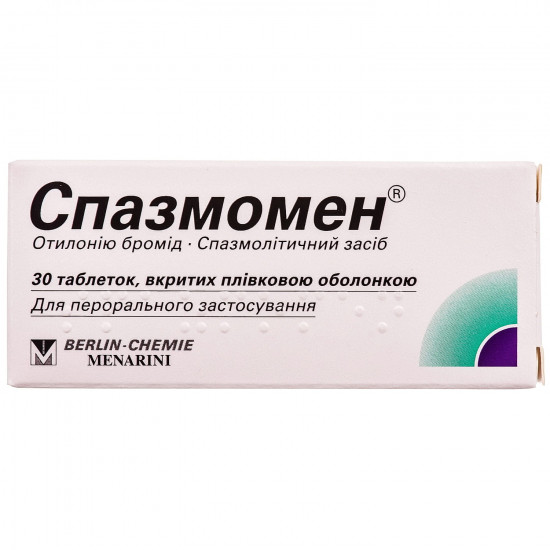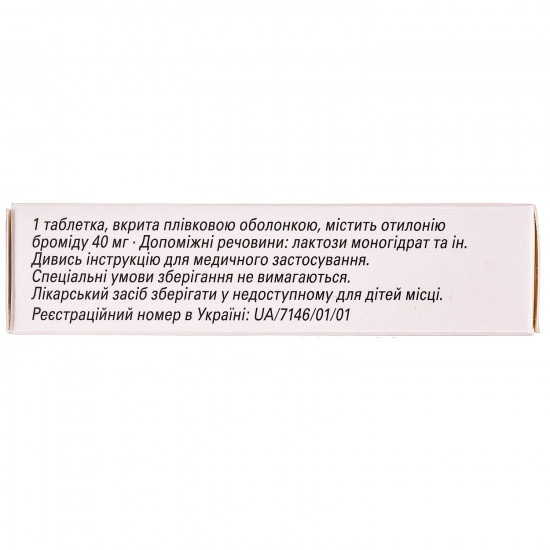



- Stock: In Stock
- Model: 184568
0% Customers recommend this product
-
5 Awesome0%
-
4 Great0%
-
3 Average0%
-
2 Bad0%
-
1 Poor0%
Reviews Over Spazmomen of the tab. of p/o of 40 mg No. 30
- (0)
Total Reviews (0)
click here write review to add review for this product.
Report this review.
Description
Pharmacological properties
Pharmacodynamics. an otiloniya bromide — the typical representative of a class of medicaments which basis yavltsya quaternary salt of 2-aminoethyl-n-benzylaminobenzoate.
Otiloniya'sbromide has spasmolytic effect on unstriated muscles of distal department of intestines (colonic and a rectum). This effect is noted at use of the doses which are not influencing gastric secretion and not causing typical atropinopodobny side effects.
action Mechanism. Otiloniya bromide acts mainly by change of current of ions of Ca 2+ between intracellular and extracellular space, reducing a trigger factor of sokratitelny activity. Otiloniya bromide inhibits opening of calcium channels of L-type and penetration of ions of Ca 2+ in unstriated muscles of intestines. The additional pharmakodinamichesky effect is reached by inhibition of takhikininovy and muskarinovy receptors.
Clinical performance and safety. The expanded analysis of double blind placebo - the controlled 15 weeks research a bromide otiloniya (research SpC1M) conducted with participation of 378 patients with the syndrome of the angry intestines (SAI) showed that the frequency of the therapeutic answer within 2–4 months was much higher in group a bromide otiloniya (36.9%) in comparison with group of placebo (22.5%; Ó =). Every month the frequency of achievement of the therapeutic answer was higher in group a bromide otiloniya in comparison with placebo (r0.05). The general monthly and week part of population with availability of the therapeutic answer concerning separate final points (intensity and frequency of pain and discomfort, a meteorism/abdominal distension, weight of diarrhea and constipation, slime in Calais) was much higher in group a bromide otiloniya in comparison with group of placebo with a range of distinctions from 10 to 20%. The analysis of results of frequency of defecation and consistence of a chair indicates that at patients with diarrhea the additional advantage is observed. Data on safety at use an otiloniya of bromide are similar to placebo.
toduring double blind placebo - controlled clinical trial (n=365 of patients with SRK) (research OBIS) confirmed efficiency a bromide otiloniya in comparison with placebo concerning decrease in frequency of an abdominal pain, degree of an abdominal distension and prevention of recuring of symptoms.
Pharmacokinetics. It is supposed that the otiloniya bromide gets into the place of pharmacological action through an intestines wall as system absorption of medicine after oral administration very low (3%). Therefore its concentration in blood plasma low. After oral administration the high rate of distribution of medicine in unstriated muscles colonic and a rectum is described. Use of medicine shortly before meal provides pharmacological effective local bioavailability of medicine in the place of therapeutic action and in waiting time of the most expressed symptoms of a disease. Use a bromide otiloniya at patients with a renal failure and a liver was not investigated. As the otiloniya bromide gets into a system blood stream in extremely insignificant quantities, deterioration in function of kidneys and a liver is not expected.
Preclinical data on safety
Acute toxicity: at oral administration at dogs of doses up to 1000 mg/kg about lethal outcomes it was not reported, and at oral administration at rats of DL 50 made 1500 mg/kg.
Chronic toxicity: at use a bromide otiloniya in a dose of 80 mg/kg within 180 days at animals any hematologic or histologic disturbances were not noted.
Embriotoxity: any embriotoksichesky and teratogenic effects at use of doses up to 60 mg/kg at rats and rabbits were not observed.
Genotoxicity: standard clinical trials of in vitro and in vivo did not reveal any mutagen potential a bromide otiloniya.
Indication
Symptomatic treatment srk and spastic pain of distal departments of intestines (colonic and a rectum), reduction of abdominal pain, abdominal distension and disturbance of a vermicular movement, caused by a spasm of unstriated muscles of distal departments of intestines at patients at the age of ≥18 years.
should begin Treatment of SRK withwith not pharmacological actions (change of lifestyle, a diet, emotional support, psychotherapy), the pharmacotherapy is appointed when such measures do not render desirable effect.
Use
Route of administration. it is necessary to swallow of tablets entirely, washing down with a glass of water. it is desirable to take a pill in 20 min. prior to food.
Dose. The recommended single dose makes 1 tablet of 40 mg, the recommended daily dose — 80–120 mg (1 tablet 2–3 times a day). The dose depends on a clinical picture and the response to treatment, medicament it is necessary to appoint according to the therapeutic managements of treatment of SRK.
Duration of treatment depends on a course of the disease. Doctors should estimate need of continuation of therapy periodically.
Special groups of patients
Patients with an abnormal liver function and kidneys. Change of a medicament dose is not required (for obtaining detailed information see Pharmacokinetics).
Patients of advanced age. Change of a medicament dose is not required.
Children. Clinical data on use of medicament for patients aged up to 18 years are limited therefore it is not intended for use for children.
Contraindication
Existence in the anamnesis of reaction of hypersensitivity to active ingredient or any component of drug.
Side effectsAt conduct of clinical trials medicament spazmomen was well transferred by
; it was reported about insignificant quantity of side reactions which on character were similar to reactions at placebo use / reference medicine (see the table).
Frequency of side reactions at the patients accepting an otiloniya bromide can be classified as follows: often (from ≥1/100 to 1/10), infrequently (from ≥1/1000 to 1/100), it is rare (from ≥1/10 000 to 1/1000).
Table. The side reactions registered during conduct of clinical trials
| from a GIT | Infrequently: dryness in a mouth, nausea, pain in an upper half of a stomach |
|---|---|
| from skin and hypodermic fabrics | Infrequently: an itching, an erythema |
| General disorders and disturbances in the injection site | Infrequently: weakness, an asthenia |
| from nervous system | Infrequently: a headache |
| from an organ of hearing and a labyrinth | Infrequently: dizziness |
by
Message about the suspected side reactions. The message about the suspected side reactions after registration of medicine plays an important role. It allows to continue observation of a ratio advantage/risk of this medicine.
Employees of healthcare institutions have to reportabout any suspected side reactions via the national warning system.
Special instructions
Drug should be used with care in glaucoma, a prostatauxe and a pylorostenosis.
Drug contains lactose therefore it is contraindicated to patients with deficiency of lactase, a galactosemia or a sprue of glucose galactose.
Use during pregnancy and feeding by a breast. Clinical data on use of the medicament Spazmomen during pregnancy and feeding by a breast are absent. During the researches Spazmomen had no embriotoksichesky, teratogenic or mutagen effect on animals and also did not show reproductive and ontogenetic toxicity. However, as well as all medicines, it is possible to apply it during pregnancy and feeding by a breast only in urgent cases and under careful observation of the doctor.
Ability to influence speed of response at control of vehicles or work with other mechanisms. Spazmomen does not influence or has extremely insignificant impact on speed of response at control of vehicles or other mechanisms.
Interaction
interaction Research a bromide otiloniya with other medicines was not conducted. it is supposed that reception a bromide otiloniya in the recommended daily dose 1 tablet 2 or 3 of time a day during time of passing of a GIT will not influence absorption of other oral medicines applied at the same time.
Overdose
In researches an otiloniya bromide had practically no toxic effect at use of the doses many times exceeding a usual pharmacological dose on animals (for obtaining detailed information see preclinical data on safety). therefore it is supposed what at overdose of medicament at the person of any serious violations should not arise. in case of overdose the symptomatic maintenance therapy is recommended. Storage conditions
Special storage conditions it is not required by
to p.
Specifications
| Characteristics | |
| Active ingredients | Otiloniya bromide |
| Amount of active ingredient | 40 mg |
| Applicant | Berlin-Chemie Menarini |
| Code of automatic telephone exchange | Otiloniya's A03AB06 bromide |
| Interaction with food | To |
| Light sensitivity | Not sensitive |
| Market status | Original |
| Origin | Chemical |
| Prescription status | According to the prescription |
| Primary packing | blister |
| Producer | BERLIN-HEMI AG |
| Quantity in packing | 30 tablets (3 blisters on 10 pieces) |
| Release form | tablets for internal use |
| Route of administration | Oral |
| Sign | Import |
| Storage temperature | from 5 °C to 30 °C |
| Trade name | Spazmomen |



















































